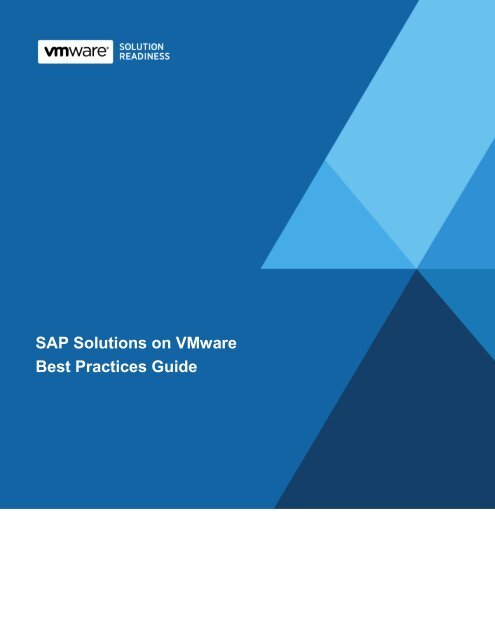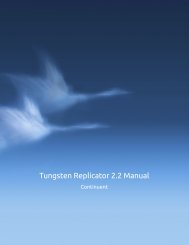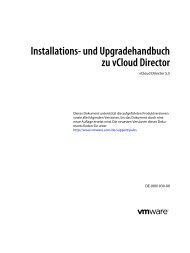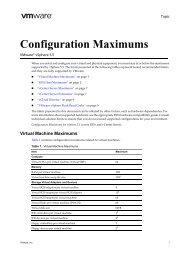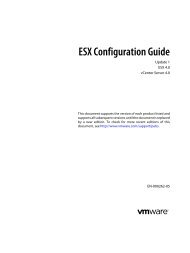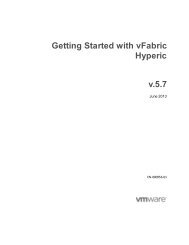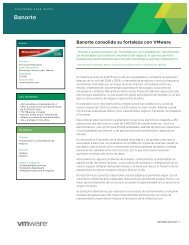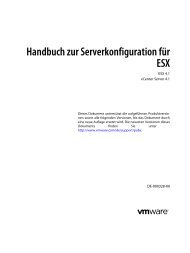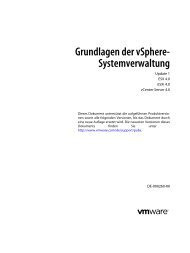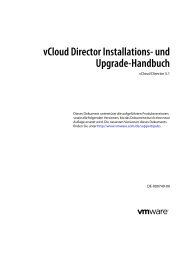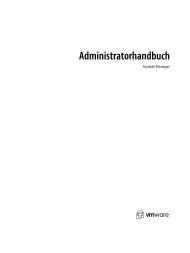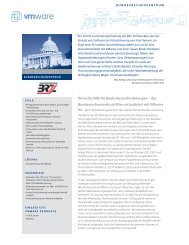Whitepaper: SAP Solutions on VMware Best Practices Guide
Whitepaper: SAP Solutions on VMware Best Practices Guide
Whitepaper: SAP Solutions on VMware Best Practices Guide
Create successful ePaper yourself
Turn your PDF publications into a flip-book with our unique Google optimized e-Paper software.
<str<strong>on</strong>g>SAP</str<strong>on</strong>g> <str<strong>on</strong>g>Soluti<strong>on</strong>s</str<strong>on</strong>g> <strong>on</strong> <strong>VMware</strong><br />
<strong>Best</strong> <strong>Practices</strong> <strong>Guide</strong>
© 2011 <strong>VMware</strong>, Inc. All rights reserved.<br />
Page 2 of 32<br />
<str<strong>on</strong>g>SAP</str<strong>on</strong>g> <str<strong>on</strong>g>Soluti<strong>on</strong>s</str<strong>on</strong>g> <strong>on</strong> <strong>VMware</strong><br />
<strong>Best</strong> <strong>Practices</strong> <strong>Guide</strong><br />
© 2011 <strong>VMware</strong>, Inc. All rights reserved. This product is protected by U.S. and internati<strong>on</strong>al copyright and<br />
intellectual property laws. This product is covered by <strong>on</strong>e or more patents listed at<br />
http://www.vmware.com/download/patents.html.<br />
<strong>VMware</strong> is a registered trademark or trademark of <strong>VMware</strong>, Inc. in the United States and/or other<br />
jurisdicti<strong>on</strong>s. All other marks and names menti<strong>on</strong>ed herein may be trademarks of their respective<br />
companies.<br />
<strong>VMware</strong>, Inc<br />
3401 Hillview Ave<br />
Palo Alto, CA 94304<br />
www.vmware.com
C<strong>on</strong>tents<br />
© 2011 <strong>VMware</strong>, Inc. All rights reserved.<br />
Page 3 of 32<br />
<str<strong>on</strong>g>SAP</str<strong>on</strong>g> <str<strong>on</strong>g>Soluti<strong>on</strong>s</str<strong>on</strong>g> <strong>on</strong> <strong>VMware</strong><br />
<strong>Best</strong> <strong>Practices</strong> <strong>Guide</strong><br />
1. Introducti<strong>on</strong> ...................................................................................... 5<br />
2. <strong>VMware</strong> vSphere ............................................................................. 5<br />
3. <str<strong>on</strong>g>SAP</str<strong>on</strong>g> Platform Overview .................................................................... 6<br />
4. Producti<strong>on</strong> Support of <str<strong>on</strong>g>SAP</str<strong>on</strong>g> <str<strong>on</strong>g>Soluti<strong>on</strong>s</str<strong>on</strong>g> <strong>on</strong> vSphere ............................ 7<br />
5. Memory and Virtual CPU ................................................................. 8<br />
5.1 Virtual Machine Memory ................................................................................................ 8<br />
5.2 Virtual CPU .................................................................................................................... 9<br />
6. Storage and Networking ................................................................. 11<br />
6.1 Storage ......................................................................................................................... 11<br />
6.2 Networking ................................................................................................................... 12<br />
7. High Availability .............................................................................. 13<br />
8. Performance and Sizing ................................................................. 16<br />
8.1 Performance ................................................................................................................. 16<br />
8.2 Performance M<strong>on</strong>itoring ............................................................................................... 18<br />
8.3 Sizing ........................................................................................................................... 19<br />
9. Timekeeping in Virtual Machines ................................................... 20<br />
10. Summary of <strong>Best</strong> <strong>Practices</strong> ........................................................ 21<br />
11. Resources.................................................................................. 26<br />
11.1 Web Resources............................................................................................................ 26<br />
11.2 <str<strong>on</strong>g>SAP</str<strong>on</strong>g> Notes .................................................................................................................... 27<br />
Appendix A: Virtual Machine Memory Settings ..................................... 28<br />
Appendix B: OS07N ESX/ESXi Performance Counters ........................ 29
© 2011 <strong>VMware</strong>, Inc. All rights reserved.<br />
Page 4 of 32<br />
<str<strong>on</strong>g>SAP</str<strong>on</strong>g> <str<strong>on</strong>g>Soluti<strong>on</strong>s</str<strong>on</strong>g> <strong>on</strong> <strong>VMware</strong><br />
<strong>Best</strong> <strong>Practices</strong> <strong>Guide</strong>
1. Introducti<strong>on</strong><br />
© 2011 <strong>VMware</strong>, Inc. All rights reserved.<br />
Page 5 of 32<br />
<str<strong>on</strong>g>SAP</str<strong>on</strong>g> <str<strong>on</strong>g>Soluti<strong>on</strong>s</str<strong>on</strong>g> <strong>on</strong> <strong>VMware</strong><br />
<strong>Best</strong> <strong>Practices</strong> <strong>Guide</strong><br />
This paper provides best practice guidelines for deploying <str<strong>on</strong>g>SAP</str<strong>on</strong>g> software soluti<strong>on</strong>s <strong>on</strong> <strong>VMware</strong> vSphere ® .<br />
These guidelines <strong>on</strong>ly provide general recommendati<strong>on</strong>s and do not target any specific size or type of<br />
<str<strong>on</strong>g>SAP</str<strong>on</strong>g> soluti<strong>on</strong> implementati<strong>on</strong>.<br />
<strong>VMware</strong> has created separate best practice documents for the individual areas of storage, networking,<br />
and performance. (See Secti<strong>on</strong> 11, Resources, for a list of these publicati<strong>on</strong>s.) <str<strong>on</strong>g>SAP</str<strong>on</strong>g> also has created a<br />
variety of technical notes, published in the <str<strong>on</strong>g>SAP</str<strong>on</strong>g> Marketplace Web site at http://service.sap.com/support,<br />
with informati<strong>on</strong> about virtualizing <str<strong>on</strong>g>SAP</str<strong>on</strong>g> soluti<strong>on</strong>s <strong>on</strong> <strong>VMware</strong> virtual infrastructure. Reference numbers of<br />
these notes are identified in this document, and you can refer to these additi<strong>on</strong>al technical notes in<br />
c<strong>on</strong>juncti<strong>on</strong> with the informati<strong>on</strong> provided here.<br />
Secti<strong>on</strong> 10, ―Summary of <strong>Best</strong> <strong>Practices</strong>,‖ provides an overview of recommendati<strong>on</strong>s discussed in this<br />
document.<br />
2. <strong>VMware</strong> vSphere<br />
<strong>VMware</strong> vSphere is the virtualizati<strong>on</strong> platform that creates a layer of abstracti<strong>on</strong> between the resources<br />
required by an applicati<strong>on</strong> and operating system, and the underlying hardware that provides those<br />
resources. A summary of the value of this abstracti<strong>on</strong> layer includes the following:<br />
C<strong>on</strong>solidati<strong>on</strong> – <strong>VMware</strong> technology allows multiple applicati<strong>on</strong> servers to be c<strong>on</strong>solidated <strong>on</strong>to <strong>on</strong>e<br />
physical server, with little or no decrease in overall performance.<br />
Ease of Provisi<strong>on</strong>ing – <strong>VMware</strong> virtualizati<strong>on</strong> encapsulates an applicati<strong>on</strong> into an image that can be<br />
duplicated or moved, greatly reducing the cost of applicati<strong>on</strong> provisi<strong>on</strong>ing and deployment.<br />
Manageability – Virtual machines can be moved from server to server with no downtime using<br />
<strong>VMware</strong> vSphere ® vMoti<strong>on</strong> ® , which simplifies comm<strong>on</strong> operati<strong>on</strong>s like hardware maintenance and<br />
reduces planned downtime.<br />
Availability – <strong>VMware</strong> High Availability (HA) makes sure that in the case of an unplanned hardware<br />
failure, affected virtual machines are restarted <strong>on</strong> another host in a <strong>VMware</strong> cluster. With HA you can<br />
reduce unplanned downtime and provide higher service levels to an applicati<strong>on</strong>. <strong>VMware</strong> vSphere ®<br />
Fault Tolerance (FT) features zero downtime, zero data loss, and c<strong>on</strong>tinuous availability in the case<br />
of server hardware failures for any applicati<strong>on</strong> running in a virtual machine.<br />
The latest versi<strong>on</strong> of vSphere is vSphere 5, which supports large capacity virtual machines that are<br />
especially well-suited to the memory-intensive and CPU-intensive footprint of <str<strong>on</strong>g>SAP</str<strong>on</strong>g> applicati<strong>on</strong>s. vSphere<br />
5 host and virtual machine specificati<strong>on</strong>s are as follows:<br />
Each <strong>VMware</strong> ESXi host supports up to 1TB RAM, 160 logical CPUs, and 2048 virtual CPUs.<br />
Each virtual machine can support up to 32 vCPUs and 1TB of RAM.
3. <str<strong>on</strong>g>SAP</str<strong>on</strong>g> Platform Overview<br />
© 2011 <strong>VMware</strong>, Inc. All rights reserved.<br />
Page 6 of 32<br />
<str<strong>on</strong>g>SAP</str<strong>on</strong>g> <str<strong>on</strong>g>Soluti<strong>on</strong>s</str<strong>on</strong>g> <strong>on</strong> <strong>VMware</strong><br />
<strong>Best</strong> <strong>Practices</strong> <strong>Guide</strong><br />
<str<strong>on</strong>g>SAP</str<strong>on</strong>g> ERP (Enterprise Resource Planning) is the <str<strong>on</strong>g>SAP</str<strong>on</strong>g> flagship product. In additi<strong>on</strong> to ERP software, other<br />
key <str<strong>on</strong>g>SAP</str<strong>on</strong>g> products and soluti<strong>on</strong>s include business intelligence, customer relati<strong>on</strong>ship management, supply<br />
chain management, supplier relati<strong>on</strong>ship management, human resource management, product life cycle<br />
management, enterprise portal software, and knowledge warehouse software.<br />
Most <str<strong>on</strong>g>SAP</str<strong>on</strong>g> applicati<strong>on</strong>s are based <strong>on</strong> the <str<strong>on</strong>g>SAP</str<strong>on</strong>g> NetWeaver technology platform. <str<strong>on</strong>g>SAP</str<strong>on</strong>g> enterprise<br />
applicati<strong>on</strong>s can be deployed in a two or three-tier architecture. The three-tier client/server architecture<br />
generally c<strong>on</strong>sists of a presentati<strong>on</strong> layer, an applicati<strong>on</strong> layer, and a database layer. These three layers<br />
can run separately <strong>on</strong> different computers or can all run together <strong>on</strong> the same computer, depending <strong>on</strong><br />
the requirements and size of the <str<strong>on</strong>g>SAP</str<strong>on</strong>g> soluti<strong>on</strong> being deployed. In three-tier c<strong>on</strong>figurati<strong>on</strong>s, the database<br />
and applicati<strong>on</strong> services reside <strong>on</strong> separate operating system (OS) images, whereas in two-tier<br />
c<strong>on</strong>figurati<strong>on</strong>s, they co-exist <strong>on</strong> the same OS image. The three-tier architecture scales to support large<br />
numbers of users. The two-tier architecture is usually sufficient for many smaller and midsize companies,<br />
as well as for sandbox, development, training, and test systems.
4. Producti<strong>on</strong> Support of <str<strong>on</strong>g>SAP</str<strong>on</strong>g> <str<strong>on</strong>g>Soluti<strong>on</strong>s</str<strong>on</strong>g> <strong>on</strong> vSphere<br />
© 2011 <strong>VMware</strong>, Inc. All rights reserved.<br />
Page 7 of 32<br />
<str<strong>on</strong>g>SAP</str<strong>on</strong>g> <str<strong>on</strong>g>Soluti<strong>on</strong>s</str<strong>on</strong>g> <strong>on</strong> <strong>VMware</strong><br />
<strong>Best</strong> <strong>Practices</strong> <strong>Guide</strong><br />
vSphere (including versi<strong>on</strong> 5) is supported by <str<strong>on</strong>g>SAP</str<strong>on</strong>g> <strong>on</strong> Linux and Windows guest operating systems as<br />
documented in <str<strong>on</strong>g>SAP</str<strong>on</strong>g> Notes 1122387 and 1409608 respectively. <str<strong>on</strong>g>SAP</str<strong>on</strong>g> Note 1492000 covers the general<br />
<str<strong>on</strong>g>SAP</str<strong>on</strong>g> support statement for virtual envir<strong>on</strong>ments. As of Q4 2011, <str<strong>on</strong>g>SAP</str<strong>on</strong>g> does not support Solaris x64 as a<br />
guest OS.<br />
<str<strong>on</strong>g>SAP</str<strong>on</strong>g> supports running the following 64-bit versi<strong>on</strong>s of <str<strong>on</strong>g>SAP</str<strong>on</strong>g> NetWeaver <strong>on</strong> <strong>VMware</strong> virtual infrastructure:<br />
<str<strong>on</strong>g>SAP</str<strong>on</strong>g> NetWeaver 2004 (<str<strong>on</strong>g>SAP</str<strong>on</strong>g> Kernel 6.40) and above (ABAP and/or JAVA stack).<br />
Older <str<strong>on</strong>g>SAP</str<strong>on</strong>g> NetWeaver and applicati<strong>on</strong> versi<strong>on</strong>s and 32-bit systems are supportable <strong>on</strong>ly during an<br />
<str<strong>on</strong>g>SAP</str<strong>on</strong>g> upgrade.<br />
For Windows, all <str<strong>on</strong>g>SAP</str<strong>on</strong>g>-certified hardware is supported as l<strong>on</strong>g as it is also <strong>on</strong> the <strong>VMware</strong> hardware<br />
compatibility list (HCL). (See the Resources secti<strong>on</strong> for the web locati<strong>on</strong> of the HCL.) A list of hardware<br />
<str<strong>on</strong>g>SAP</str<strong>on</strong>g>-certified for Windows is available at http://www.sap<strong>on</strong>win.com/.<br />
Note <str<strong>on</strong>g>SAP</str<strong>on</strong>g> has removed the requirement to certify servers specifically having <strong>VMware</strong> virtual<br />
infrastructure, and separate server certificates are no l<strong>on</strong>ger necessary.<br />
For Linux, hardware vendors have to explicitly support their hardware for Linux running <strong>on</strong> <strong>VMware</strong> virtual<br />
infrastructure. The Supported Platforms link <strong>on</strong> the <str<strong>on</strong>g>SAP</str<strong>on</strong>g> Linux support homepage<br />
(http://www.sap.com/linux) provides details. In additi<strong>on</strong>, the hardware needs to be <strong>on</strong> the <strong>VMware</strong><br />
Compatibility <strong>Guide</strong> (http://www.vmware.com/resources/compatibility/search.php).<br />
<str<strong>on</strong>g>SAP</str<strong>on</strong>g> acquired Business Objects, and Business Objects applicati<strong>on</strong>s, are also supported <strong>on</strong> <strong>VMware</strong><br />
virtual infrastructure (see <str<strong>on</strong>g>SAP</str<strong>on</strong>g> Note 1206126).<br />
<strong>VMware</strong> has worked with <str<strong>on</strong>g>SAP</str<strong>on</strong>g> to include <strong>VMware</strong> performance counters in the <str<strong>on</strong>g>SAP</str<strong>on</strong>g> OS collector program<br />
saposcol. These <strong>VMware</strong> ESX ® /ESXi counters can be viewed in <str<strong>on</strong>g>SAP</str<strong>on</strong>g> transacti<strong>on</strong> OS07N, and require<br />
applicati<strong>on</strong> of <str<strong>on</strong>g>SAP</str<strong>on</strong>g> Note 1409604, Virtualizati<strong>on</strong> <strong>on</strong> Windows: Enhanced m<strong>on</strong>itoring. (Informati<strong>on</strong> in this<br />
note also applies to Linux.) This note also must be applied to obtain <str<strong>on</strong>g>SAP</str<strong>on</strong>g> support.
5. Memory and Virtual CPU<br />
5.1 Virtual Machine Memory<br />
© 2011 <strong>VMware</strong>, Inc. All rights reserved.<br />
Page 8 of 32<br />
<str<strong>on</strong>g>SAP</str<strong>on</strong>g> <str<strong>on</strong>g>Soluti<strong>on</strong>s</str<strong>on</strong>g> <strong>on</strong> <strong>VMware</strong><br />
<strong>Best</strong> <strong>Practices</strong> <strong>Guide</strong><br />
This secti<strong>on</strong> provides guidelines for determining the number of virtual machines <strong>on</strong> a single ESX/ESXi<br />
host system based <strong>on</strong> memory requirements. See Appendix A: Virtual Machine Memory Settings for a<br />
descripti<strong>on</strong> of virtual machine memory settings discussed in this secti<strong>on</strong>. For further background <strong>on</strong><br />
<strong>VMware</strong> memory management c<strong>on</strong>cepts, see the <strong>VMware</strong> vSphere Resource Management <strong>Guide</strong> at<br />
http://pubs.vmware.com/vsphere-50/topic/com.vmware.ICbase/PDF/vsphere-esxi-vcenter-server-50resource-management-guide.pdf.<br />
Because <str<strong>on</strong>g>SAP</str<strong>on</strong>g> applicati<strong>on</strong>s are generally memory-intensive, and to account for situati<strong>on</strong>s where<br />
performance is a key factor (for example, in missi<strong>on</strong> critical producti<strong>on</strong> envir<strong>on</strong>ments), <strong>VMware</strong><br />
recommends the following:<br />
Do not over-commit memory <strong>on</strong> ESX/ESXi host servers. For producti<strong>on</strong> systems, it is possible to<br />
enforce this policy by setting the memory reservati<strong>on</strong> to the c<strong>on</strong>figured size of the virtual machine.<br />
Also note that:<br />
o Setting reservati<strong>on</strong>s may limit vMoti<strong>on</strong> migrati<strong>on</strong> capabilities. A virtual machine can <strong>on</strong>ly be<br />
migrated if the target ESX/ESXi host has free physical memory equal to or greater than the size<br />
of the reservati<strong>on</strong>.<br />
o Setting the memory reservati<strong>on</strong> to the c<strong>on</strong>figured size of the virtual machine results in a pervirtual<br />
machine VMkernel swap file of zero bytes (which c<strong>on</strong>sumes less storage).<br />
It is important to right-size the c<strong>on</strong>figured memory of a virtual machine. Memory is wasted if the <str<strong>on</strong>g>SAP</str<strong>on</strong>g><br />
applicati<strong>on</strong>s are not utilizing the c<strong>on</strong>figured memory. ESX/ESXi performance counters can be used to<br />
determine actual memory usage (see Appendix B: OS07N ESX/ESXi Performance Counters‖).<br />
The guest operating system within the virtual machine still needs its own separate swap/page file, per<br />
standard <str<strong>on</strong>g>SAP</str<strong>on</strong>g> recommendati<strong>on</strong>s.<br />
Do not disable the ballo<strong>on</strong> driver.<br />
Allocate virtual machines <strong>on</strong> a single ESX/ESXi host based <strong>on</strong> the following formula:<br />
Memory available for <str<strong>on</strong>g>SAP</str<strong>on</strong>g> virtual machines = [total ESX server physical memory] –<br />
[memory required by ESX/ESXi] - [user-defined ―memory buffer‖]<br />
Memory required by an ESX/ESXi host comprises memory required by the C<strong>on</strong>sole Operating System<br />
(COS), plus memory required by VMkernel, plus memory required for each virtual machine (which<br />
depends <strong>on</strong> the size of the virtual machine). The <strong>VMware</strong> vSphere Resource Management <strong>Guide</strong><br />
provides more detail about memory requirements.<br />
ESX/ESXi transparent page sharing makes more physical memory available, but this additi<strong>on</strong>al memory<br />
is not counted here to provide a more c<strong>on</strong>servative estimate.<br />
The memory buffer is not a <strong>VMware</strong> parameter, but is a user-defined value designed to provide<br />
headroom and flexibility to manage more virtual machines than initial estimates call for (for example, for<br />
virtual machines migrated, using vMoti<strong>on</strong>, from another ESX/ESXi host). Actual memory buffer sizes will<br />
depend <strong>on</strong> specific customer design requirements.<br />
These guidelines are purposely c<strong>on</strong>servative to avoid kernel swapping between ESX/ESXi and the guest<br />
OS, important due to the missi<strong>on</strong>-critical nature of <str<strong>on</strong>g>SAP</str<strong>on</strong>g> business processes, which must meet stringent<br />
SLAs and the memory intensive requirements of the ABAP and JAVA stack. This best practice can also<br />
apply to n<strong>on</strong>-producti<strong>on</strong> systems with high performance SLAs for developers and testers who support<br />
producti<strong>on</strong> envir<strong>on</strong>ments.
© 2011 <strong>VMware</strong>, Inc. All rights reserved.<br />
Page 9 of 32<br />
<str<strong>on</strong>g>SAP</str<strong>on</strong>g> <str<strong>on</strong>g>Soluti<strong>on</strong>s</str<strong>on</strong>g> <strong>on</strong> <strong>VMware</strong><br />
<strong>Best</strong> <strong>Practices</strong> <strong>Guide</strong><br />
Note that vSphere 5 introduces two new memory reclamati<strong>on</strong> techniques to allow users to overcommit<br />
host memory (see Understanding Memory Management in <strong>VMware</strong> vSphere 5 at<br />
http://www.vmware.com/resources/techresources/10206). Memory compressi<strong>on</strong> reduces the number of<br />
host-swapped pages by storing the compressed format of the pages in a per-VM memory compressi<strong>on</strong><br />
cache. Swap-to-SSD leverages SSD’s low read latency to alleviate the host swapping penalty. While<br />
these two new techniques can help to reduce the performance impact in memory overcommit scenarios,<br />
the above guidelines not to overcommit memory for <str<strong>on</strong>g>SAP</str<strong>on</strong>g> producti<strong>on</strong> virtual machines still stands.<br />
To minimize guest operating system swapping, the c<strong>on</strong>figured memory size of the virtual machine should<br />
be greater than the average memory usage of the <str<strong>on</strong>g>SAP</str<strong>on</strong>g> applicati<strong>on</strong> running in the guest. If the <str<strong>on</strong>g>SAP</str<strong>on</strong>g><br />
applicati<strong>on</strong> in the virtual machine needs more memory than it has been allocated, the guest operating<br />
system paging/swapping mechanisms are invoked.<br />
Memory and swap/page file c<strong>on</strong>figurati<strong>on</strong> of the <str<strong>on</strong>g>SAP</str<strong>on</strong>g> applicati<strong>on</strong> in the virtual machine follow the same<br />
guidelines as for native envir<strong>on</strong>ments, and generally, you should set them to minimize guest operating<br />
system swapping. Follow existing <str<strong>on</strong>g>SAP</str<strong>on</strong>g> documentati<strong>on</strong> and recommendati<strong>on</strong>s as provided in these <str<strong>on</strong>g>SAP</str<strong>on</strong>g><br />
notes:<br />
88416 – Zero Administrati<strong>on</strong> Memory Management as of 4.0A/Windows.<br />
1009493 – abap/heap_area* parameter Defaults Changed (64-Bit Windows).<br />
723909 – Java virtual machine settings for J2EE 6.40/7.0.<br />
941735 – <str<strong>on</strong>g>SAP</str<strong>on</strong>g> memory management for 64-bit Linux systems (or: STD memory model).<br />
386605 -- <str<strong>on</strong>g>SAP</str<strong>on</strong>g> memory management for 32-bit Linux systems (or: MAP memory model).<br />
5.2 Virtual CPU<br />
<strong>VMware</strong> uses the terms virtual CPU (vCPU) and physical CPU to distinguish between the processors<br />
within the virtual machine and the underlying physical x86-based processors. Virtual machines with more<br />
than <strong>on</strong>e virtual CPU are also called SMP (symmetric multiprocessing) virtual machines.<br />
<strong>VMware</strong> Virtual Symmetric MultiProcessing (Virtual SMP) enhances virtual machine performance by<br />
enabling a single virtual machine to use multiple physical processors simultaneously. vSphere supports<br />
use of up to 32 virtual CPUs per virtual machine. The biggest advantage of an SMP system is the ability<br />
to use multiple processors to execute multiple tasks c<strong>on</strong>currently, thereby increasing throughput (for<br />
example, the number of transacti<strong>on</strong>s per sec<strong>on</strong>d). Only workloads that support parallelizati<strong>on</strong> (including<br />
multiple processes or multiple threads that can run in parallel) can really benefit from SMP. The <str<strong>on</strong>g>SAP</str<strong>on</strong>g><br />
architecture is multithreaded (NetWeaver JAVA stack) and includes multiple processes (NetWeaver<br />
ABAP stack comprises multiple ―disp+work‖ C processes) which makes it a good candidate to take<br />
advantage of Virtual SMP.<br />
In the latest versi<strong>on</strong>s of ESX/ESXi, the CPU scheduler has underg<strong>on</strong>e several improvements to provide<br />
better performance and scalability; for details, see the paper <strong>VMware</strong> vSphere: The CPU Scheduler in<br />
<strong>VMware</strong> ESX 4.1. For example, the relaxed co-scheduling algorithm was refined so that scheduling<br />
c<strong>on</strong>straints due to co-scheduling requirements are further reduced. These improvements have resulted in<br />
better scalability and performance of <str<strong>on</strong>g>SAP</str<strong>on</strong>g> workloads, as described in Secti<strong>on</strong> 8, ―Performance and<br />
Sizing.‖ C<strong>on</strong>sequently, in vSphere, the larger 4-way and 8-way virtual machines exhibit great scalability,<br />
so that running multiple smaller 2-way virtual machines for better performance is not required as<br />
recommended with ESX/ESXi 3 versi<strong>on</strong>s.<br />
While larger virtual machines are possible in vSphere, <strong>VMware</strong> recommends reducing the number of<br />
virtual CPUs if m<strong>on</strong>itoring of the actual workload shows that the <str<strong>on</strong>g>SAP</str<strong>on</strong>g> applicati<strong>on</strong> is not benefitting from<br />
the increased virtual CPUs. For more background, please see the ―ESXi CPU C<strong>on</strong>siderati<strong>on</strong>s‖ secti<strong>on</strong> in<br />
the whitepaper Performance <strong>Best</strong> <strong>Practices</strong> for <strong>VMware</strong> vSphere 5.
© 2011 <strong>VMware</strong>, Inc. All rights reserved.<br />
Page 10 of 32<br />
<str<strong>on</strong>g>SAP</str<strong>on</strong>g> <str<strong>on</strong>g>Soluti<strong>on</strong>s</str<strong>on</strong>g> <strong>on</strong> <strong>VMware</strong><br />
<strong>Best</strong> <strong>Practices</strong> <strong>Guide</strong><br />
Note that <str<strong>on</strong>g>SAP</str<strong>on</strong>g> has c<strong>on</strong>ducted tests <strong>on</strong> virtual CPU overcommitment (documented in Note 1122388), and<br />
shows the performance degradati<strong>on</strong> inside the virtual machines is linearly reciprocal to the overcommitment.<br />
As the performance degradati<strong>on</strong> is ―graceful,‖ any virtual CPU overcommitments can be<br />
effectively managed by using vMoti<strong>on</strong> to migrate virtual machines to other ESX/ESXi hosts to obtain more<br />
processing power.<br />
Hyperthreading technology (recent versi<strong>on</strong>s of which are called symmetric multithreading, or SMT) allows<br />
a single physical processor core to behave like two logical processors, essentially allowing two<br />
independent threads to run simultaneously. Unlike having twice as many processor cores—which can<br />
roughly double performance—hyper-threading can provide anywhere from a slight to a significant<br />
increase in system performance by keeping the processor pipeline busier. For example, an ESX/ESXi<br />
host system enabled for SMT <strong>on</strong> an 8-core server sees 16 threads that appear as 16 logical processors.<br />
Recent <str<strong>on</strong>g>SAP</str<strong>on</strong>g> benchmarks were c<strong>on</strong>ducted <strong>on</strong> SMT-enabled servers—these are covered in Secti<strong>on</strong> 8.
6. Storage and Networking<br />
6.1 Storage<br />
© 2011 <strong>VMware</strong>, Inc. All rights reserved.<br />
Page 11 of 32<br />
<str<strong>on</strong>g>SAP</str<strong>on</strong>g> <str<strong>on</strong>g>Soluti<strong>on</strong>s</str<strong>on</strong>g> <strong>on</strong> <strong>VMware</strong><br />
<strong>Best</strong> <strong>Practices</strong> <strong>Guide</strong><br />
It is preferred practice to deploy virtual machines files <strong>on</strong> shared storage to take advantage of vMoti<strong>on</strong><br />
and <strong>VMware</strong> HA. This practice aligns well with <str<strong>on</strong>g>SAP</str<strong>on</strong>g> soluti<strong>on</strong>-based deployments, which are typically<br />
installed <strong>on</strong> third-party shared storage management soluti<strong>on</strong>s.<br />
The following two methods of storage c<strong>on</strong>figurati<strong>on</strong> are covered here:<br />
<strong>VMware</strong> Virtual Machine File System (VMFS) is a clustered file system that provides storage<br />
virtualizati<strong>on</strong> optimized for virtual machines.<br />
Raw Device Mapping (RDM) provides a mechanism for a virtual machine to have direct access to a<br />
volume <strong>on</strong> a physical storage subsystem. RDM can <strong>on</strong>ly be used with Fibre Channel or iSCSI.<br />
<strong>VMware</strong> generally recommends the use of VMFS. You can use RDM where existing systems already<br />
make use of third-party storage management software so that you can use RDM to leverage existing<br />
practices and tools, for example:<br />
Storage-based backups to disk.<br />
Database-c<strong>on</strong>sistent replicati<strong>on</strong> in DR scenarios.<br />
Where RDM is required when using third-party clustering software.<br />
RDM enables quicker migrati<strong>on</strong> between physical server and virtual envir<strong>on</strong>ments. Database files in<br />
either physical or virtual envir<strong>on</strong>ments can be accessed just as they are, without the need for a data<br />
c<strong>on</strong>versi<strong>on</strong> to or from VMFS format.<br />
A mixed storage c<strong>on</strong>figurati<strong>on</strong> is viable for an <str<strong>on</strong>g>SAP</str<strong>on</strong>g> virtual machine—the guest operating system is<br />
installed with VMFS and the <str<strong>on</strong>g>SAP</str<strong>on</strong>g> database files with RDM. <strong>VMware</strong> template cl<strong>on</strong>ing can be used for the<br />
guest operating system and database files can be managed by third party storage management software.<br />
Generally, for performance-critical producti<strong>on</strong> <str<strong>on</strong>g>SAP</str<strong>on</strong>g> databases, follow these recommendati<strong>on</strong>s:<br />
Spread out database data files over multiple LUNs, similar to those in native setups, following the<br />
storage vendor array guidelines for database layout, LUN, and spindle c<strong>on</strong>figurati<strong>on</strong>.<br />
Use multiple virtual SCSI c<strong>on</strong>trollers for database virtual machines. The use of multiple virtual SCSI<br />
c<strong>on</strong>trollers allows the executi<strong>on</strong> of several parallel I/O operati<strong>on</strong>s inside the guest OS. It is<br />
recommended to use <strong>on</strong>e c<strong>on</strong>troller for OS and swap, <strong>on</strong>e c<strong>on</strong>troller for redo/log, and <strong>on</strong>e or more<br />
c<strong>on</strong>trollers for data files.<br />
Use the PVSCSI adapter for database files – this offers a significant reducti<strong>on</strong> in CPU utilizati<strong>on</strong> as<br />
well as potentially increased throughput.<br />
Use eager-zeroed thick disks for database files. An eager-zeroed thick disk has all space allocated<br />
and zeroed out at the time of creati<strong>on</strong>. This increases the time it takes to create the disk, but results in<br />
the best performance during database operati<strong>on</strong>s, such as when the database autogrows its data<br />
files.<br />
Follow the guidelines in the ―ESXi Storage C<strong>on</strong>siderati<strong>on</strong>s‖ and ―Guest Operating Systems‖ secti<strong>on</strong>s of<br />
Performance <strong>Best</strong> <strong>Practices</strong> for <strong>VMware</strong> vSphere 5.
6.2 Networking<br />
© 2011 <strong>VMware</strong>, Inc. All rights reserved.<br />
Page 12 of 32<br />
<str<strong>on</strong>g>SAP</str<strong>on</strong>g> <str<strong>on</strong>g>Soluti<strong>on</strong>s</str<strong>on</strong>g> <strong>on</strong> <strong>VMware</strong><br />
<strong>Best</strong> <strong>Practices</strong> <strong>Guide</strong><br />
The standard <strong>VMware</strong> networking best practices apply to running <str<strong>on</strong>g>SAP</str<strong>on</strong>g> applicati<strong>on</strong>s <strong>on</strong> vSphere:<br />
Allocate separate network adapters/networks for vMoti<strong>on</strong>, <strong>VMware</strong> FT logging traffic, and ESX/ESXi<br />
c<strong>on</strong>sole access management.<br />
Allocate at least two network adapters for <str<strong>on</strong>g>SAP</str<strong>on</strong>g> data traffic to leverage <strong>VMware</strong> NIC teaming<br />
capabilities. Generally, at least four network adapters are recommended for each ESX/ESXi host.<br />
Use the VMXNET3 network adapter - this is a paravirtualized device that works <strong>on</strong>ly if <strong>VMware</strong> Tools<br />
is installed <strong>on</strong> the guest operating system. The VMXNET3 adapter is optimized for virtual<br />
envir<strong>on</strong>ments and designed to provide high performance.<br />
To support VLANs in vSphere, the virtual or physical network must tag the Ethernet frames with<br />
802.1Q tags using virtual switch tagging (VST), virtual machine guest tagging (VGT), or external<br />
switch tagging (EST). VST mode is the most comm<strong>on</strong> c<strong>on</strong>figurati<strong>on</strong>.<br />
Follow the networking design guidelines in VMworld 2011 sessi<strong>on</strong> VSP3864 <strong>Best</strong> <strong>Practices</strong> for Virtual<br />
Networking. This includes designs to efficiently manage multiple networks and redundancy of network<br />
adaptors <strong>on</strong> ESX/ESXi hosts.<br />
Follow the guidelines in the ―ESXi Networking C<strong>on</strong>siderati<strong>on</strong>s‖ and ―Guest Operating Systems‖<br />
secti<strong>on</strong>s of Performance <strong>Best</strong> <strong>Practices</strong> for <strong>VMware</strong> vSphere 5.
7. High Availability<br />
© 2011 <strong>VMware</strong>, Inc. All rights reserved.<br />
Page 13 of 32<br />
<str<strong>on</strong>g>SAP</str<strong>on</strong>g> <str<strong>on</strong>g>Soluti<strong>on</strong>s</str<strong>on</strong>g> <strong>on</strong> <strong>VMware</strong><br />
<strong>Best</strong> <strong>Practices</strong> <strong>Guide</strong><br />
The <strong>VMware</strong> Fault Tolerance (FT) and <strong>VMware</strong> High Availability (HA) features together can provide high<br />
availability opti<strong>on</strong>s for <str<strong>on</strong>g>SAP</str<strong>on</strong>g> single points of failure in the virtualized envir<strong>on</strong>ment.<br />
<strong>VMware</strong> FT protects a virtual machine by maintaining a sec<strong>on</strong>d virtual machine that runs in lockstep with<br />
the primary virtual machine. If the primary virtual machine goes down, the sec<strong>on</strong>dary machine takes over<br />
with no downtime. Currently, <strong>VMware</strong> FT supports <strong>on</strong>ly single-CPU virtual machines and is a viable<br />
soluti<strong>on</strong> for lightweight comp<strong>on</strong>ents of the <str<strong>on</strong>g>SAP</str<strong>on</strong>g> architecture such as Central Services. When deploying<br />
<str<strong>on</strong>g>SAP</str<strong>on</strong>g> Central Services standal<strong>on</strong>e in a virtual machine, note the following:<br />
Linux-based guest OS is supported by <str<strong>on</strong>g>SAP</str<strong>on</strong>g> and there are no caveats.<br />
For Windows-based guest OS, see <str<strong>on</strong>g>SAP</str<strong>on</strong>g> note 1609304, Installing a standal<strong>on</strong>e ASCS instance. To<br />
obtain support <strong>on</strong> Windows for a standal<strong>on</strong>e Central Services deployment in a virtual machine follow<br />
these guidelines:<br />
o Use a sapinst that allows installati<strong>on</strong> of standal<strong>on</strong>e Central Services (available from NetWeaver<br />
7.3, but also possible with some earlier versi<strong>on</strong>s).<br />
o Take care of RFC destinati<strong>on</strong>s that point to the virtual hostname of the Central Services by<br />
maintaining RFC group destinati<strong>on</strong>s or implementing a standal<strong>on</strong>e gateway.<br />
o In case of an upgrade, choose the correct upgrade tools (if you need advice, open a <str<strong>on</strong>g>SAP</str<strong>on</strong>g><br />
message under support comp<strong>on</strong>ent BC-UPG).<br />
o For clarificati<strong>on</strong>, open a <str<strong>on</strong>g>SAP</str<strong>on</strong>g> ticket under support comp<strong>on</strong>ent BC-OP-NT-ESX before proceeding<br />
with an installati<strong>on</strong>.<br />
<strong>VMware</strong> HA c<strong>on</strong>tinuously m<strong>on</strong>itors all ESX/ESXi hosts in a cluster and, in case of an ESX/ESXi host<br />
failure, restarts all affected virtual machines <strong>on</strong> the remaining hosts.<br />
Though <strong>VMware</strong> HA and <strong>VMware</strong> FT can provide ESX/ESXi server hardware protecti<strong>on</strong> to <str<strong>on</strong>g>SAP</str<strong>on</strong>g> single<br />
points of failure, it does not m<strong>on</strong>itor the health of the applicati<strong>on</strong> (that is, <str<strong>on</strong>g>SAP</str<strong>on</strong>g> database and Central<br />
Instance or Central Services). If applicati<strong>on</strong> level m<strong>on</strong>itoring is also required, then investigate using thirdparty<br />
clustering software in virtual machines (in-guest clustering), or a soluti<strong>on</strong> from Symantec, called<br />
Applicati<strong>on</strong>HA, which integrates with <strong>VMware</strong> HA. Table 1 summarizes the HA soluti<strong>on</strong>s.<br />
Table 1. Summary of High Availability Scenarios<br />
HA Scenario Hardware<br />
Protecti<strong>on</strong><br />
<strong>VMware</strong> HA<br />
<strong>VMware</strong> FT (SCS)<br />
Symantec<br />
Applicati<strong>on</strong>HA +<br />
<strong>VMware</strong> HA<br />
Applicati<strong>on</strong><br />
Aware<br />
Rolling Patch<br />
Upgrade<br />
Support<br />
Guest-OS boot Complexity<br />
after H/W failure Cost<br />
Yes No No Yes Low<br />
Yes Yes No Yes Medium<br />
In-guest Clustering Yes Yes Yes No High
Table 2 identifies the different in-guest clustering soluti<strong>on</strong>s available <strong>on</strong> <strong>VMware</strong>.<br />
Table 2. Cluster <str<strong>on</strong>g>Soluti<strong>on</strong>s</str<strong>on</strong>g> Supported <strong>on</strong> <strong>VMware</strong> by Vendors<br />
Cluster<br />
Soluti<strong>on</strong><br />
Microsoft<br />
Cluster<br />
Symantec/<br />
Veritas Cluster<br />
Services<br />
SUSE High<br />
Availability<br />
Extensi<strong>on</strong><br />
Red Hat<br />
Clustering<br />
Vendor<br />
Support<br />
RDM VMFS Guest OS Comments<br />
© 2011 <strong>VMware</strong>, Inc. All rights reserved.<br />
Page 14 of 32<br />
<str<strong>on</strong>g>SAP</str<strong>on</strong>g> <str<strong>on</strong>g>Soluti<strong>on</strong>s</str<strong>on</strong>g> <strong>on</strong> <strong>VMware</strong><br />
<strong>Best</strong> <strong>Practices</strong> <strong>Guide</strong><br />
Yes Yes No Windows Requires RDM, cannot vMoti<strong>on</strong><br />
migrate clustered virtual<br />
machine.<br />
Yes Yes No Windows,<br />
SUSE Linux,<br />
Red Hat Linux<br />
See <strong>VMware</strong> guide Setup for<br />
Failover Clustering and<br />
Microsoft Cluster Service.<br />
For iSCSI and FC SAN<br />
requires RDM. Cannot use<br />
vMoti<strong>on</strong> to migrate clustered<br />
virtual machines.<br />
http://www.symantec.com/c<strong>on</strong>n<br />
ect/articles/clusteringc<strong>on</strong>figurati<strong>on</strong>s-supported-vcsvsphere<br />
Yes Yes Yes SUSE Linux For VMFS, need to use ―multiwriter<br />
flag‖. See <strong>VMware</strong> KB<br />
article 1034165. Enables<br />
vMoti<strong>on</strong>.<br />
http://www.ccdresden.de/en/whitepaper<br />
Yes Yes Yes Red Hat Linux Supported by Red Hat from 5.7<br />
and later.<br />
Oracle RAC Yes Yes Yes SUSE Linux,<br />
Red Hat Linux<br />
For VMFS, need to use ―multiwriter<br />
flag‖, see <strong>VMware</strong> KB<br />
article 1034165. Enables<br />
vMoti<strong>on</strong>.<br />
Supported by Oracle from<br />
11.2.0.2 and later as per<br />
MyOracleSupport, Document<br />
ID #249212.1.<br />
For VMFS, need to use ―multiwriter<br />
flag‖, see <strong>VMware</strong> KB<br />
article 1034165. Enables<br />
vMoti<strong>on</strong>.
© 2011 <strong>VMware</strong>, Inc. All rights reserved.<br />
Page 15 of 32<br />
<str<strong>on</strong>g>SAP</str<strong>on</strong>g> <str<strong>on</strong>g>Soluti<strong>on</strong>s</str<strong>on</strong>g> <strong>on</strong> <strong>VMware</strong><br />
<strong>Best</strong> <strong>Practices</strong> <strong>Guide</strong><br />
Given that there are different high availability design choices available for <str<strong>on</strong>g>SAP</str<strong>on</strong>g> installati<strong>on</strong> <strong>on</strong> <strong>VMware</strong><br />
virtual infrastructure, the final approach taken depends <strong>on</strong> your specific business and sizing requirements<br />
and Service Level Agreements (SLAs). The following c<strong>on</strong>siderati<strong>on</strong>s may influence your choices:<br />
If <strong>on</strong>ly hardware protecti<strong>on</strong> is required, <strong>VMware</strong> HA and <strong>VMware</strong> FT provide an ec<strong>on</strong>omical choice,<br />
as it is easy to c<strong>on</strong>figure <strong>VMware</strong> ―out-of-the-box‖ functi<strong>on</strong>ality without the complexity of installing<br />
clustering software.<br />
The decisi<strong>on</strong> not to go with applicati<strong>on</strong> level m<strong>on</strong>itoring may depend <strong>on</strong> your previous failover<br />
experiences with clustering software. For example how often a failover occurs due to applicati<strong>on</strong><br />
failure <strong>on</strong>ly (for example, OS, database, Central Instance) and hardware was not the source of the<br />
problem.<br />
Many customers who run <str<strong>on</strong>g>SAP</str<strong>on</strong>g> soluti<strong>on</strong>s <strong>on</strong> <strong>VMware</strong> virtual infrastructure have fulfilled their high<br />
availability SLAs with <strong>VMware</strong> HA, which has lowered their total cost of ownership (TCO). You can<br />
find examples in a detailed study of three customer implementati<strong>on</strong>s documented in the whitepaper<br />
TCO and ROI Analysis of <str<strong>on</strong>g>SAP</str<strong>on</strong>g> Landscapes using <strong>VMware</strong> Technology (see Secti<strong>on</strong> 11, Resources,<br />
secti<strong>on</strong> for the document link).<br />
If sizing of the <str<strong>on</strong>g>SAP</str<strong>on</strong>g> system is such that all <str<strong>on</strong>g>SAP</str<strong>on</strong>g> locking and messaging activities can be satisfied by<br />
<strong>on</strong>e core of the latest x86-technology based processor, then zero-downtime protecti<strong>on</strong> against<br />
hardware failure for Central Services is possible with <strong>VMware</strong> FT without the complexity of<br />
c<strong>on</strong>figuring replicated enqueue in a clustered envir<strong>on</strong>ment. (This scenario assumes Central Services<br />
is installed in a single virtual CPU virtual machine.) For larger systems, an in-house performance test<br />
may be required to determine suitability.<br />
If you require applicati<strong>on</strong> level m<strong>on</strong>itoring for the database, Central Instance or Central Services:<br />
o Symantec Applicati<strong>on</strong> HA helps to bridge the gap between <strong>VMware</strong> HA and in-guest clustering.<br />
o Clustering software in virtual machines can provide applicati<strong>on</strong> m<strong>on</strong>itoring and rolling patch<br />
upgrade capability however, you will need cluster c<strong>on</strong>figurati<strong>on</strong> skills and may have to pay for<br />
additi<strong>on</strong>al cluster software license costs.<br />
The final design choice depends <strong>on</strong> how much downtime a business can realistically tolerate, and the<br />
cost they are willing to invest in the extra resources and skills to install and operate software that<br />
provides applicati<strong>on</strong> m<strong>on</strong>itoring. It is a trade-off.
8. Performance and Sizing<br />
8.1 Performance<br />
Benchmark test results for <str<strong>on</strong>g>SAP</str<strong>on</strong>g> ERP running <strong>on</strong> vSphere are available at<br />
http://www.sap.com/soluti<strong>on</strong>s/benchmark/index.epx.<br />
The following table summarizes the vSphere certificati<strong>on</strong>s as of Q4 2011.<br />
Table 3. <str<strong>on</strong>g>SAP</str<strong>on</strong>g> <strong>on</strong> vSphere Benchmarks (+ <strong>on</strong>e Native for comparis<strong>on</strong>) Q4 2011<br />
Cert 2-tier/<br />
3-tier<br />
vSphere<br />
Versi<strong>on</strong><br />
Virtual<br />
Machines<br />
© 2011 <strong>VMware</strong>, Inc. All rights reserved.<br />
Page 16 of 32<br />
<str<strong>on</strong>g>SAP</str<strong>on</strong>g> <str<strong>on</strong>g>Soluti<strong>on</strong>s</str<strong>on</strong>g> <strong>on</strong> <strong>VMware</strong><br />
<strong>Best</strong> <strong>Practices</strong> <strong>Guide</strong><br />
Users <str<strong>on</strong>g>SAP</str<strong>on</strong>g>S Server<br />
C<strong>on</strong>figurati<strong>on</strong><br />
2009028 2-tier vSphere 4 4-way 1144 6250 8 cores<br />
16 threads<br />
2009029 2-tier vSphere 4 8-way 2056 11230 8 cores<br />
16 threads<br />
2010016 3-tier vSphere 4 15 x<br />
8-way<br />
2011044 3-tier vSphere 5 20 x 12-way +<br />
20-way<br />
16000 87800 8 cores<br />
16 threads<br />
32125 175320 12 cores<br />
24 threads<br />
2011027 2-tier vSphere 5 24-way 4600 25120 12 cores<br />
24 threads<br />
2011028 2-tier NATIVE N/A 4875 26630 12 cores<br />
24 threads<br />
“<str<strong>on</strong>g>SAP</str<strong>on</strong>g>S‖ stands for <str<strong>on</strong>g>SAP</str<strong>on</strong>g> Applicati<strong>on</strong> Performance Standard, a hardware-independent unit that<br />
describes the performance of a <str<strong>on</strong>g>SAP</str<strong>on</strong>g> system c<strong>on</strong>figurati<strong>on</strong> (further details are available at<br />
http://www.sap.com/soluti<strong>on</strong>s/benchmark/measuring/index.epx).<br />
All the certificati<strong>on</strong>s above are <strong>on</strong> servers with hyperthreading enabled.<br />
Certificati<strong>on</strong>s 2009028 and 2009029 – The total number of vCPUs is
© 2011 <strong>VMware</strong>, Inc. All rights reserved.<br />
Page 17 of 32<br />
<str<strong>on</strong>g>SAP</str<strong>on</strong>g> <str<strong>on</strong>g>Soluti<strong>on</strong>s</str<strong>on</strong>g> <strong>on</strong> <strong>VMware</strong><br />
<strong>Best</strong> <strong>Practices</strong> <strong>Guide</strong><br />
Separate 3-tier <str<strong>on</strong>g>SAP</str<strong>on</strong>g> OLTP tests <strong>on</strong> ESX/ESXi servers with hyperthreading enabled <strong>on</strong> Intel Xe<strong>on</strong> 5500 or<br />
higher has shown up to a 24% gain in performance from hyperthreading (for background, refer to the<br />
<strong>VMware</strong> performance blog listed in the Resources secti<strong>on</strong>).<br />
To maximize performance of <str<strong>on</strong>g>SAP</str<strong>on</strong>g> applicati<strong>on</strong>s in the virtual envir<strong>on</strong>ment, <strong>VMware</strong> recommends the<br />
following:<br />
Use the latest hardware to exploit vSphere support of hardware nested page tables to obtain the best<br />
<str<strong>on</strong>g>SAP</str<strong>on</strong>g> applicati<strong>on</strong> performance <strong>on</strong> vSphere.<br />
4-way and 8-way applicati<strong>on</strong> server virtual machines are viable for envir<strong>on</strong>ments running <strong>on</strong><br />
vSphere. Note that in ESX/ESXi 3.X versi<strong>on</strong>s, 2-way virtual machines are still optimum.<br />
Where possible size the virtual machine so that it fits within a NUMA node (virtual memory is less<br />
than NUMA node memory and vCPU count that is less than or equal to the number of processors per<br />
node). This c<strong>on</strong>figurati<strong>on</strong> allows vSphere to employ NUMA optimizati<strong>on</strong>s for memory and CPU<br />
scheduling and ensures that all memory accesses will be satisfied by the memory closest to the<br />
processor<br />
vSphere 5 introduces virtual NUMA whereby ESXi 5.0 exposes NUMA topology to the guest<br />
operating system, allowing NUMA-aware guest operating systems and applicati<strong>on</strong>s to make the most<br />
efficient use of the underlying hardware’s NUMA architecture. For <str<strong>on</strong>g>SAP</str<strong>on</strong>g> systems, where sizing<br />
dictates, large single instance databases can be installed in a wide virtual machine that crosses<br />
NUMA nodes and virtual NUMA sockets can be defined for the virtual machine. In this setup, the<br />
database will behave in similar manner to when installed <strong>on</strong> a large NUMA based physical server and<br />
the NUMA optimizati<strong>on</strong>s of the database will determine the performance benefits.<br />
o See the paper Performance <strong>Best</strong> <strong>Practices</strong> for <strong>VMware</strong> vSphere 5 for further virtual NUMA<br />
guidelines and c<strong>on</strong>figurati<strong>on</strong> steps.<br />
o C<strong>on</strong>sult your database vendor documentati<strong>on</strong> to determine NUMA optimizati<strong>on</strong> settings for the<br />
database.<br />
Install the latest versi<strong>on</strong> of <strong>VMware</strong> Tools in the guest operating system.<br />
Download and follow guidelines in the following <str<strong>on</strong>g>SAP</str<strong>on</strong>g> Notes<br />
o 1056052 – Windows: <strong>VMware</strong> ESX/ESXi 3.x or vSphere c<strong>on</strong>figurati<strong>on</strong> guidelines.<br />
o 1122388 – Linux: <strong>VMware</strong> ESX Server 3 c<strong>on</strong>figurati<strong>on</strong> guidelines.<br />
For vSphere 4, follow the guidelines in <strong>VMware</strong> KB article 1020233 HaltingIdleMsecPenalty<br />
Parameter: Guidance for Modifying vSphere's Fairness/Throughput Balance to maximize benefits of<br />
hyperthreading. This KB article is not required for vSphere 5.
8.2 Performance M<strong>on</strong>itoring<br />
© 2011 <strong>VMware</strong>, Inc. All rights reserved.<br />
Page 18 of 32<br />
<str<strong>on</strong>g>SAP</str<strong>on</strong>g> <str<strong>on</strong>g>Soluti<strong>on</strong>s</str<strong>on</strong>g> <strong>on</strong> <strong>VMware</strong><br />
<strong>Best</strong> <strong>Practices</strong> <strong>Guide</strong><br />
For performance m<strong>on</strong>itoring, ESX/ESXi performance counters are available in <str<strong>on</strong>g>SAP</str<strong>on</strong>g> transacti<strong>on</strong> OS07N<br />
(see <str<strong>on</strong>g>SAP</str<strong>on</strong>g> Note 1409604 for Windows and Note 1102124 for Linux). Appendix B: OS07N ESX/ESXi<br />
Performance Counters includes a screen capture and a descripti<strong>on</strong> of the virtual counters. OS07N<br />
provides a starting point from which you can m<strong>on</strong>itor the virtual envir<strong>on</strong>ment. For performance<br />
troubleshooting, <strong>VMware</strong> recommends following the guidelines in the paper Performance Troubleshooting<br />
for <strong>VMware</strong> vSphere 4. (See Secti<strong>on</strong> 11, Resources, for Web site locati<strong>on</strong>.) This paper provides a guide<br />
for checks including:<br />
ESX/ESXi host CPU saturati<strong>on</strong>.<br />
ESX/ESXi host server swapping.<br />
Virtual machine guest CPU saturati<strong>on</strong>.<br />
Network and storage issues.<br />
Access to <strong>VMware</strong> vCenter Server through the vSphere client is required to view the major ESX/ESXi<br />
performance counters necessary for troubleshooting CPU, memory, storage, and network issues.<br />
Table 4 highlights some useful counters (for a full list of counter, see <strong>VMware</strong> Communities: Interpreting<br />
esxtop Statistics at http://communities.vmware.com/docs/DOC-9279).<br />
Table 4. Some Useful ESX/ESXi Performance Counters<br />
Subsystem esxtop<br />
Counters<br />
CPU %RDY Ready (ms in a 20s<br />
window)<br />
vCenter Counter Descripti<strong>on</strong> (Threshold)<br />
Measures CPU c<strong>on</strong>tenti<strong>on</strong> between virtual<br />
machines (< 5% per vCPU).<br />
%USED Usage CPU utilizati<strong>on</strong> of virtual machine.<br />
Memory %ACTV Active Guest memory being actively used.<br />
SWW/s<br />
SWR/s<br />
Swapin Rate<br />
Swapout Rate<br />
Storage DAVG/cmd deviceWriteLatency and<br />
deviceReadLatency<br />
KAVG/cmd kernelWriteLatency and<br />
kernelReadLatency<br />
ESX/ESXi host swap counters: with no<br />
memory overcommit these should be zero.<br />
I/O latency from ESX/ESXi to storage array<br />
(10-20ms).<br />
I/O latency in hypervisor (< 1 ms).<br />
Network %DRPTX Dropped Packets Percentage of transmit packets dropped (0).
8.3 Sizing<br />
© 2011 <strong>VMware</strong>, Inc. All rights reserved.<br />
Page 19 of 32<br />
<str<strong>on</strong>g>SAP</str<strong>on</strong>g> <str<strong>on</strong>g>Soluti<strong>on</strong>s</str<strong>on</strong>g> <strong>on</strong> <strong>VMware</strong><br />
<strong>Best</strong> <strong>Practices</strong> <strong>Guide</strong><br />
<str<strong>on</strong>g>SAP</str<strong>on</strong>g> has established a sizing process with its hardware partners to determine the hardware requirements<br />
to implement an <str<strong>on</strong>g>SAP</str<strong>on</strong>g> system. The sizing process uses the Web-based Quick Sizer tool, which calculates<br />
<str<strong>on</strong>g>SAP</str<strong>on</strong>g> requirements based <strong>on</strong> throughput numbers, and the number of users working with the different <str<strong>on</strong>g>SAP</str<strong>on</strong>g><br />
Business Suite comp<strong>on</strong>ents, in a hardware and database independent format. For more informati<strong>on</strong>, go<br />
to http://service.sap.com/sizing. (<str<strong>on</strong>g>SAP</str<strong>on</strong>g> Marketplace access is required to reach this site.)<br />
No changes to the Quick Sizer process are needed for a virtualized system c<strong>on</strong>figurati<strong>on</strong>—follow the<br />
same process when sizing for either a virtual or a physical envir<strong>on</strong>ment. After obtaining the results of a<br />
Quick Sizer project, work with the <str<strong>on</strong>g>SAP</str<strong>on</strong>g> Competency Center of your specific hardware vendor for sizing<br />
and architecture services as you would for physical envir<strong>on</strong>ments. <strong>VMware</strong> works closely with the same<br />
<str<strong>on</strong>g>SAP</str<strong>on</strong>g> hardware partners so that they have the equivalent <str<strong>on</strong>g>SAP</str<strong>on</strong>g>S ratings for virtual machines, as these are<br />
directly related to the speed of the processor.<br />
The following c<strong>on</strong>siderati<strong>on</strong>s are applicable for sizing <str<strong>on</strong>g>SAP</str<strong>on</strong>g> soluti<strong>on</strong>s <strong>on</strong> <strong>VMware</strong> virtual infrastructure:<br />
C<strong>on</strong>sult the <str<strong>on</strong>g>SAP</str<strong>on</strong>g> Competency Center of a specific hardware vendor for a detailed architecture design<br />
and official sizing estimate.<br />
Use the Quick Sizer tool in the normal manner to obtain <str<strong>on</strong>g>SAP</str<strong>on</strong>g>S requirements for <str<strong>on</strong>g>SAP</str<strong>on</strong>g> business<br />
modules.<br />
Note that generally, a direct certified benchmark comparis<strong>on</strong> between a <strong>VMware</strong> virtual platform and<br />
the equivalent physical implementati<strong>on</strong> <strong>on</strong> the same server may not be possible. This is because the<br />
virtual result is based <strong>on</strong> 90 percent or greater CPU utilizati<strong>on</strong> within the virtual machine and the<br />
underlying physical ESX/ESXi host may not be fully utilized.<br />
Hardware vendors have an approximate general memory requirement per core for <str<strong>on</strong>g>SAP</str<strong>on</strong>g> applicati<strong>on</strong>s.<br />
The same requirement is applicable for virtual CPUs, so the per-core memory rating is equivalent to<br />
the virtual CPU rating. For example, a 4-8GB per-core requirement translates to the same 4-8GB<br />
requirement per virtual CPU.<br />
To determine the number of virtual machines for an ESX/ESXi host from a memory standpoint, follow<br />
the guidelines provided in Secti<strong>on</strong> 5, ―Memory and Virtual CPU.‖
9. Timekeeping in Virtual Machines<br />
© 2011 <strong>VMware</strong>, Inc. All rights reserved.<br />
Page 20 of 32<br />
<str<strong>on</strong>g>SAP</str<strong>on</strong>g> <str<strong>on</strong>g>Soluti<strong>on</strong>s</str<strong>on</strong>g> <strong>on</strong> <strong>VMware</strong><br />
<strong>Best</strong> <strong>Practices</strong> <strong>Guide</strong><br />
Most operating systems track the passage of time by c<strong>on</strong>figuring the underlying hardware to provide<br />
periodic interrupts. The rate at which those interrupts are c<strong>on</strong>figured to arrive varies for different operating<br />
systems. High timer-interrupt rates can incur overhead that affects a virtual machine's performance. The<br />
amount of overhead increases with the number of vCPUs assigned to a virtual machine.<br />
For many Linux operating systems, the default timer interrupt-rate is high and can lead to time<br />
synchr<strong>on</strong>izati<strong>on</strong> errors in <str<strong>on</strong>g>SAP</str<strong>on</strong>g> applicati<strong>on</strong>s running in virtual machines:<br />
Error messages in the <str<strong>on</strong>g>SAP</str<strong>on</strong>g> Syslog: "System time was set externally to a time in the past. Wait 1<br />
sec<strong>on</strong>d(s)."<br />
At the operating system level, the clock of the virtual machine might run too quickly or too slowly.<br />
Time drift between the applicati<strong>on</strong> and database server can cause ABAP short dumps with the error<br />
message ―ZDATE_LARGE_TIME_DIFF.‖<br />
To address timekeeping issues when running <str<strong>on</strong>g>SAP</str<strong>on</strong>g> soluti<strong>on</strong>s <strong>on</strong> Linux guest operating systems:<br />
o Use Novell SLES 9 and later versi<strong>on</strong>s, or Red Hat RHEL 5.1 and later, because these operating<br />
system versi<strong>on</strong>s allow the frequency of timer interrupts to be reduced.<br />
o Follow the guidelines in <str<strong>on</strong>g>SAP</str<strong>on</strong>g> Note 989963 – Linux: <strong>VMware</strong> timing problem.
10. Summary of <strong>Best</strong> <strong>Practices</strong><br />
© 2011 <strong>VMware</strong>, Inc. All rights reserved.<br />
Page 21 of 32<br />
<str<strong>on</strong>g>SAP</str<strong>on</strong>g> <str<strong>on</strong>g>Soluti<strong>on</strong>s</str<strong>on</strong>g> <strong>on</strong> <strong>VMware</strong><br />
<strong>Best</strong> <strong>Practices</strong> <strong>Guide</strong><br />
This secti<strong>on</strong> summarizes best practices. See Secti<strong>on</strong> 11.2, <str<strong>on</strong>g>SAP</str<strong>on</strong>g> Notes, for the locati<strong>on</strong> of <str<strong>on</strong>g>SAP</str<strong>on</strong>g> notes<br />
menti<strong>on</strong>ed in the following recommendati<strong>on</strong>s.<br />
Item Comments<br />
Recommendati<strong>on</strong> Download and follow guidelines in the following <str<strong>on</strong>g>SAP</str<strong>on</strong>g> Notes: 1056052<br />
Windows: <strong>VMware</strong> ESX 3.x or vSphere c<strong>on</strong>figurati<strong>on</strong> guidelines; 1122388 -<br />
Linux: <strong>VMware</strong> ESX Server 3 c<strong>on</strong>figurati<strong>on</strong> guideline.<br />
Justificati<strong>on</strong> These notes are updated, so download the latest versi<strong>on</strong>s. The different<br />
<str<strong>on</strong>g>SAP</str<strong>on</strong>g> memory models are described in these notes.<br />
Item Comments<br />
Recommendati<strong>on</strong> Set memory reservati<strong>on</strong>s equal to the size to the virtual machine<br />
Justificati<strong>on</strong> To avoid kernel swapping between ESX/ESXi and the guest OS because<br />
<str<strong>on</strong>g>SAP</str<strong>on</strong>g> applicati<strong>on</strong> and database servers can be memory-intensive.<br />
Item Comments<br />
Recommendati<strong>on</strong> Use large memory pages for databases.<br />
Justificati<strong>on</strong> Large page support is enabled by default in ESX/ESXi versi<strong>on</strong>s 3.5 and<br />
later, and is supported in Linux and Windows. Enable large pages in the<br />
guest OS to improve the performance of <str<strong>on</strong>g>SAP</str<strong>on</strong>g> applicati<strong>on</strong>s <strong>on</strong> vSphere. <str<strong>on</strong>g>SAP</str<strong>on</strong>g><br />
applicati<strong>on</strong> servers do not support large pages.<br />
Item Comments<br />
Recommendati<strong>on</strong> Use as few virtual CPUs (vCPUs) as possible.<br />
Justificati<strong>on</strong> If m<strong>on</strong>itoring of the actual workload shows that the <str<strong>on</strong>g>SAP</str<strong>on</strong>g> applicati<strong>on</strong> is not<br />
benefitting from the increased virtual CPUs, the excess vCPUs impose<br />
scheduling c<strong>on</strong>straints and can degrade overall performance of the virtual<br />
machine.<br />
Item Comments<br />
Recommendati<strong>on</strong> Spread database files out over multiple datastores/LUNs.<br />
Justificati<strong>on</strong> The creati<strong>on</strong> of dedicated datastores for I/O-intensive databases is<br />
analogous to provisi<strong>on</strong>ing dedicated LUNs in the physical world. This is a<br />
typical design practice for missi<strong>on</strong>-critical enterprise workloads.
Item Comments<br />
© 2011 <strong>VMware</strong>, Inc. All rights reserved.<br />
Page 22 of 32<br />
<str<strong>on</strong>g>SAP</str<strong>on</strong>g> <str<strong>on</strong>g>Soluti<strong>on</strong>s</str<strong>on</strong>g> <strong>on</strong> <strong>VMware</strong><br />
<strong>Best</strong> <strong>Practices</strong> <strong>Guide</strong><br />
Recommendati<strong>on</strong> Use eager-zeroed thick disk for database and <str<strong>on</strong>g>SAP</str<strong>on</strong>g> applicati<strong>on</strong> server files.<br />
Justificati<strong>on</strong> Provides better performance during database operati<strong>on</strong>s, for example, when<br />
the database autogrows its data files there is no first zero write penalty.<br />
Item Comments<br />
Recommendati<strong>on</strong> Make sure VMFS is correctly aligned.<br />
Justificati<strong>on</strong> Like other disk-based file systems, VMFS incurs a performance penalty<br />
when the partiti<strong>on</strong> is unaligned. Use <strong>VMware</strong> vCenter to create VMFS<br />
partiti<strong>on</strong>s because it automatically aligns the partiti<strong>on</strong>s.<br />
Item Comments<br />
Recommendati<strong>on</strong> Avoid silos when designing the storage architecture.<br />
Justificati<strong>on</strong> When designing an optimized architecture, involve the database, storage,<br />
<strong>VMware</strong>, and <str<strong>on</strong>g>SAP</str<strong>on</strong>g> Basis administrator.<br />
Item Comments<br />
Recommendati<strong>on</strong> Use paravirtualized SCSI adapters for database datafiles<br />
Justificati<strong>on</strong> The combinati<strong>on</strong> of the new paravirtualized SCSI driver (pvscsi) and<br />
additi<strong>on</strong>al ESX/ESXi kernel-level storage stack optimizati<strong>on</strong>s dramatically<br />
improves storage I/O performance.<br />
Item Comments<br />
Recommendati<strong>on</strong> Spread the database files over all the virtual SCSI c<strong>on</strong>trollers.<br />
Justificati<strong>on</strong> Maximizes parallel processing of I/O in the guest OS.<br />
Item Comments<br />
Recommendati<strong>on</strong> Use the VMXNET family of paravirtualized network adapters.<br />
Justificati<strong>on</strong> The paravirtualized network adapters in the VMXNET family implement an<br />
optimized network interface that passes network traffic between the virtual<br />
machine and the physical network interface cards with minimal overhead.
Item Comments<br />
© 2011 <strong>VMware</strong>, Inc. All rights reserved.<br />
Page 23 of 32<br />
<str<strong>on</strong>g>SAP</str<strong>on</strong>g> <str<strong>on</strong>g>Soluti<strong>on</strong>s</str<strong>on</strong>g> <strong>on</strong> <strong>VMware</strong><br />
<strong>Best</strong> <strong>Practices</strong> <strong>Guide</strong><br />
Recommendati<strong>on</strong> Separate infrastructure traffic from virtual machine traffic for security and<br />
isolati<strong>on</strong>.<br />
Justificati<strong>on</strong> Virtual machines should not see infrastructure traffic (security violati<strong>on</strong>) and<br />
should not be impacted by infrastructure traffic bursts (for example, by<br />
vMoti<strong>on</strong>).<br />
Item Comments<br />
Recommendati<strong>on</strong> Use NIC teaming for availability and load balancing.<br />
Justificati<strong>on</strong> NIC teams can share the load of traffic am<strong>on</strong>g some or all of its members, or<br />
provide passive failover in case of a hardware failure or a network outage.<br />
Item Comments<br />
Recommendati<strong>on</strong> When installing standal<strong>on</strong>e Central Services <strong>on</strong> Windows, follow <str<strong>on</strong>g>SAP</str<strong>on</strong>g> note<br />
1609304, Installing a standal<strong>on</strong>e ASCS instance. For clarificati<strong>on</strong> open an<br />
<str<strong>on</strong>g>SAP</str<strong>on</strong>g> ticket under support comp<strong>on</strong>ent BC-OP-NT-ESX.<br />
Justificati<strong>on</strong> If sizing permits standal<strong>on</strong>e, Central Services in a <strong>on</strong>e-way virtual machine<br />
can be protected under <strong>VMware</strong> Fault Tolerance.<br />
Item Comments<br />
Recommendati<strong>on</strong> When deploying clustering software from SUSE, Redhat, or RAC, follow<br />
<strong>VMware</strong> KB article 1034165, Disabling simultaneous write protecti<strong>on</strong><br />
provided by VMFS using the multi-writer flag at<br />
http://kb.vmware.com/selfservice/microsites/search.do?language=en_US&c<br />
md=displayKC&externalId=1034165 . This uses the ―multi-writer flag‖ to<br />
enable sharing of vmdks by multiple virtual machines.<br />
Justificati<strong>on</strong> In guest clustering software may be required to satisfy some customer SLAs.<br />
Clustering with VMFS provides compatibility with vMoti<strong>on</strong>.
Item Comments<br />
© 2011 <strong>VMware</strong>, Inc. All rights reserved.<br />
Page 24 of 32<br />
<str<strong>on</strong>g>SAP</str<strong>on</strong>g> <str<strong>on</strong>g>Soluti<strong>on</strong>s</str<strong>on</strong>g> <strong>on</strong> <strong>VMware</strong><br />
<strong>Best</strong> <strong>Practices</strong> <strong>Guide</strong><br />
Recommendati<strong>on</strong> Use the virtual counters in OS07N to m<strong>on</strong>itor the virtual envir<strong>on</strong>ment as a<br />
starting point. For advanced troubleshooting, use <strong>VMware</strong> vCenter and/or the<br />
esxtop/resxtop utility.<br />
Justificati<strong>on</strong> CPU and memory usage reported within the guest OS can be different from<br />
what ESX/ESXi reports. No ESX/ESXi disk counters are available in OS07N.<br />
Item Comments<br />
Recommendati<strong>on</strong> C<strong>on</strong>figure virtual NUMA sockets for wide virtual machines that need to cross<br />
NUMA nodes. Follow guidelines in Performance <strong>Best</strong> <strong>Practices</strong> for <strong>VMware</strong><br />
vSphere 5 at http://www.vmware.com/resources/techresources/10199.<br />
Justificati<strong>on</strong> Depending <strong>on</strong> sizing requirements, large database virtual machines might<br />
need to be larger than a NUMA node. ESXi 5.0 exposes NUMA topology to<br />
the guest operating system, allowing NUMA-aware guest operating systems<br />
and databases to make the most efficient use of the underlying hardware’s<br />
NUMA architecture.<br />
Item Comments<br />
Recommendati<strong>on</strong> To minimize time drift in virtual machines, follow the guidelines in <str<strong>on</strong>g>SAP</str<strong>on</strong>g> Note<br />
989963 – Linux: <strong>VMware</strong> timing problem.<br />
Justificati<strong>on</strong> The impact of high timer-interrupts in some operating systems can lead to time<br />
synchr<strong>on</strong>izati<strong>on</strong> errors.<br />
Item Comments<br />
Recommendati<strong>on</strong> Use vShield App to protect and isolate <str<strong>on</strong>g>SAP</str<strong>on</strong>g> virtual machines in c<strong>on</strong>solidated<br />
ESX/ESXi clusters.<br />
Justificati<strong>on</strong> Enable security compliance by providing network isolati<strong>on</strong> between producti<strong>on</strong><br />
and n<strong>on</strong>-producti<strong>on</strong> landscapes, different <str<strong>on</strong>g>SAP</str<strong>on</strong>g> products, database and<br />
applicati<strong>on</strong> tier, and the like. (See paper in Resources secti<strong>on</strong>).
Some further general c<strong>on</strong>siderati<strong>on</strong>s include the following:<br />
© 2011 <strong>VMware</strong>, Inc. All rights reserved.<br />
Page 25 of 32<br />
<str<strong>on</strong>g>SAP</str<strong>on</strong>g> <str<strong>on</strong>g>Soluti<strong>on</strong>s</str<strong>on</strong>g> <strong>on</strong> <strong>VMware</strong><br />
<strong>Best</strong> <strong>Practices</strong> <strong>Guide</strong><br />
<strong>VMware</strong> virtual machine cl<strong>on</strong>ing from templates that include a previously-installed <str<strong>on</strong>g>SAP</str<strong>on</strong>g> instance can<br />
drastically decrease the time required to provisi<strong>on</strong> new <str<strong>on</strong>g>SAP</str<strong>on</strong>g> systems, databases, and applicati<strong>on</strong><br />
servers by making reinstallati<strong>on</strong> of the guest OS, database, and <str<strong>on</strong>g>SAP</str<strong>on</strong>g> software unnecessary. You will<br />
have to make further <str<strong>on</strong>g>SAP</str<strong>on</strong>g> applicati<strong>on</strong>-specific changes after provisi<strong>on</strong>ing a new virtual machine to<br />
change the <str<strong>on</strong>g>SAP</str<strong>on</strong>g> SID and hostname to make the new instance unique.<br />
Generally, after you have correctly sized virtual machines with the memory and virtual CPUs required<br />
for the workload, administrati<strong>on</strong> of the <str<strong>on</strong>g>SAP</str<strong>on</strong>g> applicati<strong>on</strong> instance within the virtual machine is the same<br />
as with physical infrastructure, and the standard <str<strong>on</strong>g>SAP</str<strong>on</strong>g> Basis administrati<strong>on</strong> tasks and procedures<br />
apply.<br />
An <str<strong>on</strong>g>SAP</str<strong>on</strong>g> <strong>on</strong> <strong>VMware</strong> forum is available and hosted by the <str<strong>on</strong>g>SAP</str<strong>on</strong>g> Developer Network. This forum is<br />
moderated by <str<strong>on</strong>g>SAP</str<strong>on</strong>g> and <strong>VMware</strong> engineers and is a good place for discussi<strong>on</strong>s and technical questi<strong>on</strong>s.<br />
C<strong>on</strong>sult papers and Web sources listed in Secti<strong>on</strong> 11, ―Resources,‖ to provide more background and<br />
details <strong>on</strong> the recommendati<strong>on</strong>s specified in this document.<br />
The guidelines documented here have enabled <strong>VMware</strong> partners and customers to successfully size,<br />
architect, and deploy <str<strong>on</strong>g>SAP</str<strong>on</strong>g> soluti<strong>on</strong>s <strong>on</strong> <strong>VMware</strong> virtual infrastructure. Published success stories are<br />
available at the following URL:<br />
http://www.vmware.com/partners/alliances/technology/sap.html.
11. Resources<br />
© 2011 <strong>VMware</strong>, Inc. All rights reserved.<br />
Page 26 of 32<br />
<str<strong>on</strong>g>SAP</str<strong>on</strong>g> <str<strong>on</strong>g>Soluti<strong>on</strong>s</str<strong>on</strong>g> <strong>on</strong> <strong>VMware</strong><br />
<strong>Best</strong> <strong>Practices</strong> <strong>Guide</strong><br />
This secti<strong>on</strong> lists Web sites where you can obtain more informati<strong>on</strong> about using <strong>VMware</strong> and <str<strong>on</strong>g>SAP</str<strong>on</strong>g><br />
soluti<strong>on</strong>s.<br />
11.1 Web Resources<br />
<strong>VMware</strong> and <str<strong>on</strong>g>SAP</str<strong>on</strong>g> Web site (success stories, whitepapers, technical case studies):<br />
http://www.vmware.com/partners/alliances/technology/sap.html<br />
<str<strong>on</strong>g>SAP</str<strong>on</strong>g> <strong>on</strong> <strong>VMware</strong> forum at the <str<strong>on</strong>g>SAP</str<strong>on</strong>g> Community Network:<br />
http://forums.sdn.sap.com/forum.jspa?forumID=471<br />
Performance <strong>Best</strong> <strong>Practices</strong> for <strong>VMware</strong> vSphere 5:<br />
http://www.vmware.com/resources/techresources/10199<br />
Understanding Memory Management in <strong>VMware</strong> vSphere 5:<br />
http://www.vmware.com/resources/techresources/10206<br />
<strong>VMware</strong> Compatibility <strong>Guide</strong>:<br />
http://www.vmware.com/resources/compatibility/search.php<br />
<strong>VMware</strong> vSphere Resource Management <strong>Guide</strong>:<br />
http://pubs.vmware.com/vsphere-50/topic/com.vmware.ICbase/PDF/vsphere-esxi-vcenter-server-50resource-management-guide.pdf<br />
C<strong>on</strong>figurati<strong>on</strong> Maximums <strong>VMware</strong> vSphere 5.0:<br />
http://www.vmware.com/pdf/vsphere5/r50/vsphere-50-c<strong>on</strong>figurati<strong>on</strong>-maximums.pdf<br />
<strong>VMware</strong> vSphere: The CPU Scheduler in <strong>VMware</strong> ESX 4.1:<br />
http://www.vmware.com/resources/techresources/10131<br />
Performance Troubleshooting for <strong>VMware</strong> vSphere 4.1:<br />
http://www.vmware.com/resources/techresources/10179<br />
VMworld 2011 sessi<strong>on</strong> VSP3864 <strong>Best</strong> <strong>Practices</strong> for Virtual Networking:<br />
http://www.vmworld.com/community/sessi<strong>on</strong>s (VMworld account required)<br />
vSphere Guest Programming <strong>Guide</strong>, <strong>VMware</strong> vSphere Guest SDK 4:<br />
http://www.vmware.com/support/developer/guest-sdk/guest_sdk_40.pdf<br />
<str<strong>on</strong>g>SAP</str<strong>on</strong>g> SD Standard Applicati<strong>on</strong> Benchmark Results, Two-Tier and Three-Tier C<strong>on</strong>figurati<strong>on</strong>s (includes<br />
benchmarks c<strong>on</strong>ducted <strong>on</strong> vSphere):<br />
http://www.sap.com/soluti<strong>on</strong>s/benchmark/index.epx<br />
TCO and ROI Analysis of <str<strong>on</strong>g>SAP</str<strong>on</strong>g> Landscapes using <strong>VMware</strong> Technology:<br />
http://www.vmware.com/files/pdf/partners/sap/<str<strong>on</strong>g>SAP</str<strong>on</strong>g>_TCOROI_Customers_Final.pdf<br />
<strong>VMware</strong> KB article 1020233 HaltingIdleMsecPenalty Parameter: Guidance for Modifying vSphere's<br />
Fairness/Throughput Balance:<br />
http://kb.vmware.com/selfservice/microsites/search.do?language=en_US&cmd=displayKC&externalId<br />
=1020233
© 2011 <strong>VMware</strong>, Inc. All rights reserved.<br />
Page 27 of 32<br />
<str<strong>on</strong>g>SAP</str<strong>on</strong>g> <str<strong>on</strong>g>Soluti<strong>on</strong>s</str<strong>on</strong>g> <strong>on</strong> <strong>VMware</strong><br />
<strong>Best</strong> <strong>Practices</strong> <strong>Guide</strong><br />
<strong>VMware</strong> Performance VROOM! Blog – <str<strong>on</strong>g>SAP</str<strong>on</strong>g> Three-Tier Shows Excellent Scaling <strong>on</strong> vSphere:<br />
http://blogs.vmware.com/performance/2010/03/sap-threetier-shows-excellent-scaling-<strong>on</strong>-vsphere.html<br />
Ready Time Blog:<br />
http://communities.vmware.com/docs/DOC-7390<br />
<strong>VMware</strong> KB article 1008205 – Using esxtop to identify storage performance issues:<br />
http://kb.vmware.com/kb/1008205<br />
<strong>VMware</strong> vShield App Protecting Virtual <str<strong>on</strong>g>SAP</str<strong>on</strong>g> Deployments:<br />
http://www.vmware.com/resources/techresources/10213<br />
11.2 <str<strong>on</strong>g>SAP</str<strong>on</strong>g> Notes<br />
A list of <str<strong>on</strong>g>SAP</str<strong>on</strong>g> <strong>on</strong> vSphere notes is available at the following locati<strong>on</strong>:<br />
http://forums.sdn.sap.com/thread.jspa?threadID=1524523<br />
More notes are available at the <str<strong>on</strong>g>SAP</str<strong>on</strong>g> Marketplace Web site at http://service.sap.com/support. (This site<br />
requires login credentials.)
Appendix A: Virtual Machine Memory Settings<br />
Figure 1 shows the memory settings used for a virtual machine.<br />
Figure 1. Virtual Machine Memory Settings<br />
C<strong>on</strong>figured memory – Memory size of virtual machine assigned at creati<strong>on</strong>.<br />
Active memory – Memory recently accessed by applicati<strong>on</strong>s in the virtual machine.<br />
© 2011 <strong>VMware</strong>, Inc. All rights reserved.<br />
Page 28 of 32<br />
<str<strong>on</strong>g>SAP</str<strong>on</strong>g> <str<strong>on</strong>g>Soluti<strong>on</strong>s</str<strong>on</strong>g> <strong>on</strong> <strong>VMware</strong><br />
<strong>Best</strong> <strong>Practices</strong> <strong>Guide</strong><br />
Reservati<strong>on</strong> – Guaranteed lower bound <strong>on</strong> the amount of memory that the host reserves for the<br />
virtual machine, which cannot be reclaimed by ESX/ESXi for other virtual machines.<br />
Swappable – Virtual machine memory that can be reclaimed by the ballo<strong>on</strong> driver or, worst case, by<br />
ESX/ESXi swapping. This is the automatic size of the per-virtual-machine swap file that is created <strong>on</strong><br />
the VMFS file system (.vswp file).<br />
For more informati<strong>on</strong> about <strong>VMware</strong> ESX/ESXi memory management c<strong>on</strong>cepts and the ballo<strong>on</strong> driver,<br />
see the <strong>VMware</strong> vSphere Resource Management <strong>Guide</strong> at http://pubs.vmware.com/vsphere-<br />
50/topic/com.vmware.ICbase/PDF/vsphere-esxi-vcenter-server-50-resource-management-guide.pdf.
Appendix B: OS07N ESX/ESXi Performance Counters<br />
© 2011 <strong>VMware</strong>, Inc. All rights reserved.<br />
Page 29 of 32<br />
<str<strong>on</strong>g>SAP</str<strong>on</strong>g> <str<strong>on</strong>g>Soluti<strong>on</strong>s</str<strong>on</strong>g> <strong>on</strong> <strong>VMware</strong><br />
<strong>Best</strong> <strong>Practices</strong> <strong>Guide</strong><br />
The vSphere Guest API provides functi<strong>on</strong>s that management agents and other software can use to<br />
collect data about the state and performance of a <strong>VMware</strong> ESX/ESXi virtual machine. The API is part of<br />
<strong>VMware</strong> Tools that is installed in the guest operating system of the virtual machine. The <str<strong>on</strong>g>SAP</str<strong>on</strong>g> operating<br />
system collector agent saposcol has been updated to call the vSphere Guest APIs to extract virtual<br />
informati<strong>on</strong> for presentati<strong>on</strong> in transacti<strong>on</strong> OS07N. Figure 2 shows a screen capture of OS07N with the<br />
virtual counters.<br />
Figure 2. Screen Capture of OS07N after Applicati<strong>on</strong> of <str<strong>on</strong>g>SAP</str<strong>on</strong>g> Note 1409604
© 2011 <strong>VMware</strong>, Inc. All rights reserved.<br />
Page 30 of 32<br />
<str<strong>on</strong>g>SAP</str<strong>on</strong>g> <str<strong>on</strong>g>Soluti<strong>on</strong>s</str<strong>on</strong>g> <strong>on</strong> <strong>VMware</strong><br />
<strong>Best</strong> <strong>Practices</strong> <strong>Guide</strong><br />
The following table provides an overview and descripti<strong>on</strong> of the virtual counters that can be seen in<br />
transacti<strong>on</strong> OS07N. For more informati<strong>on</strong> <strong>on</strong> counters listed in the table below, see <str<strong>on</strong>g>SAP</str<strong>on</strong>g> Note 1260719<br />
and the vSphere Guest Programming <strong>Guide</strong>.<br />
Table 5. Descripti<strong>on</strong> of <strong>VMware</strong> Performance Counters<br />
OS07N Counter <strong>VMware</strong> Counter Descripti<strong>on</strong> Nearest vCenter Counter<br />
M<strong>on</strong>itoring Category: CPU Virtualizati<strong>on</strong> Host<br />
Physical CPUs used for<br />
virtualizati<strong>on</strong>.<br />
CPU time spent <strong>on</strong><br />
virtualizati<strong>on</strong> (cumulative<br />
time in sec<strong>on</strong>ds).<br />
Number of logical CPUs used by<br />
the virtual machines and<br />
hypervisor.<br />
Total time used for executing<br />
guest OS and virtualizati<strong>on</strong> code<br />
for all virtual machines.<br />
M<strong>on</strong>itoring Category: CPU Virtualizati<strong>on</strong> Virtual System<br />
Minimum CPUs<br />
available.<br />
Maximum CPUs<br />
available.<br />
CPU time spent for this<br />
virtual server (cumulative<br />
time in sec<strong>on</strong>ds since<br />
virtual machine start).<br />
Time virtual CPU not<br />
backed by hypervisor<br />
(cumulative time in<br />
sec<strong>on</strong>ds since virtual<br />
machine start).<br />
Physical CPUs used for<br />
virtualizati<strong>on</strong>.<br />
Select host > Summary > Resources<br />
pane > CPU usage (MHz).<br />
Select host > Performance tab ><br />
Advanced > Chart Opti<strong>on</strong>s > CPU ><br />
Real-Time > Used (ms); measured per<br />
time slice.<br />
CPU reservati<strong>on</strong> setting. Select virtual machine > Edit Settings ><br />
Resources > CPU > Reservati<strong>on</strong> (MHz).<br />
Max number of logical processors<br />
allowed to be used for virtual<br />
machine.<br />
Time used by the guest OS and<br />
virtualizati<strong>on</strong> code for this virtual<br />
machine.<br />
Time virtual machine is scheduled,<br />
but no CPU was available to let it<br />
run.<br />
Number of logical CPUs used by<br />
the virtual machine.<br />
Generally not recommended, value<br />
should be zero.<br />
Select virtual machine > Edit Settings ><br />
Resources > CPU > Limit (MHz).<br />
By default, this is set to ―unlimited‖ so limit<br />
is number of vCPUs assigned to virtual<br />
machine.<br />
Select virtual machine >Performance tab<br />
> Advanced > Chart Opti<strong>on</strong>s > CPU ><br />
Real- Time > Used (ms); measured per<br />
time slice.<br />
Select virtual machine -> Performance<br />
tab > Advanced > Chart Opti<strong>on</strong>s > CPU<br />
> Real-Time > Ready (ms); measured<br />
per time slice.<br />
Use the vCenter metrics for Ready and<br />
CPU Usage to troubleshoot ESX/ESXi<br />
host CPU saturati<strong>on</strong> as per <strong>VMware</strong><br />
performance troubleshooting whitepaper.<br />
Select virtual machine > Summary tab ><br />
Resources pane, C<strong>on</strong>sumed Host CPU<br />
(MHz).
OS07N Counter <strong>VMware</strong> Counter Descripti<strong>on</strong> Nearest vCenter Counter<br />
M<strong>on</strong>itoring Category: Memory Virtualizati<strong>on</strong> Host<br />
Physical memory used by<br />
virtual systems (MB).<br />
Memory shared between<br />
virtual servers (MB).<br />
Memory paged by<br />
virtualizati<strong>on</strong> platform<br />
(MB).<br />
Total physical memory allocated<br />
by all virtual machines.<br />
Memory savings obtained through<br />
transparent page sharing <strong>on</strong><br />
ESX/ESXi host.<br />
Total amount of memory swapped<br />
out for all virtual machines <strong>on</strong> the<br />
ESX/ESXi host.<br />
Memory available (MB). Total amount of free physical<br />
memory that is available <strong>on</strong><br />
ESX/ESXi host for virtual<br />
machines.<br />
M<strong>on</strong>itoring Category: Memory Virtualizati<strong>on</strong> Virtual System<br />
Minimum memory<br />
available (MB).<br />
Physical memory<br />
allocated to virtual<br />
system (MB).<br />
Memory used by virtual<br />
system (MB).<br />
Shared memory used by<br />
virtual system (MB).<br />
Memory reservati<strong>on</strong> for the virtual<br />
machine.<br />
User c<strong>on</strong>figured memory size of<br />
virtual machine.<br />
Amount of memory recently<br />
accessed by virtual machine.<br />
Amount of physical memory<br />
associated with this virtual<br />
machine that is shared via<br />
Transparent page Sharing.<br />
© 2011 <strong>VMware</strong>, Inc. All rights reserved.<br />
Page 31 of 32<br />
<str<strong>on</strong>g>SAP</str<strong>on</strong>g> <str<strong>on</strong>g>Soluti<strong>on</strong>s</str<strong>on</strong>g> <strong>on</strong> <strong>VMware</strong><br />
<strong>Best</strong> <strong>Practices</strong> <strong>Guide</strong><br />
Select host > Summary > Resources<br />
pane > Memory usage (MB).<br />
Select host > Performance tab ><br />
Advanced > Chart Opti<strong>on</strong>s > Memory ><br />
Real-Time > Shared (KB).<br />
Select host > Performance tab ><br />
Advanced > Memory > Chart Opti<strong>on</strong>s ><br />
Memory > Real-Time > "Swap out.‖<br />
Select host > C<strong>on</strong>figurati<strong>on</strong> tab ><br />
Memory > Virtual Machines (<strong>on</strong> right)<br />
Select virtual machine > Edit Settings ><br />
Resources > Memory > Reservati<strong>on</strong><br />
(MB).<br />
To enforce no memory over-commitment,<br />
this can be set to the c<strong>on</strong>figured memory<br />
size of the virtual machine.<br />
Select virtual machine > Summary ><br />
General pane > Memory (MB).<br />
Select virtual machine > Summary ><br />
Resources pane > Active Guest<br />
Memory (MB).<br />
If sum of active memory of all virtual<br />
machines <strong>on</strong> ESX/ESXi host is greater<br />
than physical memory available for virtual<br />
machines, then high likelihood of<br />
performance degradati<strong>on</strong>.<br />
Select virtual machine > Resource<br />
Allocati<strong>on</strong> > Memory pane > Guest<br />
Memory > Shared (GB).
OS07N Counter <strong>VMware</strong> Counter Descripti<strong>on</strong> Nearest vCenter Counter<br />
Desired virtual server<br />
memory size (MB).<br />
Rate of pages paged In<br />
(/s).<br />
Other Useful Counters:<br />
Size of the target memory<br />
allocati<strong>on</strong> for this virtual machine.<br />
Amount of memory reclaimed from<br />
virtual machine by swapping guest<br />
memory to virtual machine swap<br />
file.<br />
Not available. System-wide memory used by<br />
hypervisor kernel (System)<br />
Not available. Memory used by each virtual<br />
machine (depends <strong>on</strong> size of<br />
virtual machine)<br />
Not available. ESX/ESXi Network + Disk<br />
statistics.<br />
© 2011 <strong>VMware</strong>, Inc. All rights reserved.<br />
Page 32 of 32<br />
<str<strong>on</strong>g>SAP</str<strong>on</strong>g> <str<strong>on</strong>g>Soluti<strong>on</strong>s</str<strong>on</strong>g> <strong>on</strong> <strong>VMware</strong><br />
<strong>Best</strong> <strong>Practices</strong> <strong>Guide</strong><br />
Target value set by VMkernal for virtual<br />
machine’s memory ballo<strong>on</strong> size. Used by<br />
VMkernel to inflate and deflate the<br />
ballo<strong>on</strong> driver for a virtual machine.<br />
Select virtual machine > Resource<br />
Allocati<strong>on</strong> > Memory pane > Guest<br />
Memory > Swapped (MB).<br />
If there is no memory over-commitment,<br />
this will be zero.<br />
Select host > C<strong>on</strong>figurati<strong>on</strong> > Hardware<br />
pane > Memory > System (<strong>on</strong> right)<br />
Select virtual machine > Summary ><br />
General pane > Memory Overhead<br />
(MB).<br />
See performance troubleshooting white<br />
paper:<br />
http://communities.vmware.com/docs/DO<br />
C-10352


